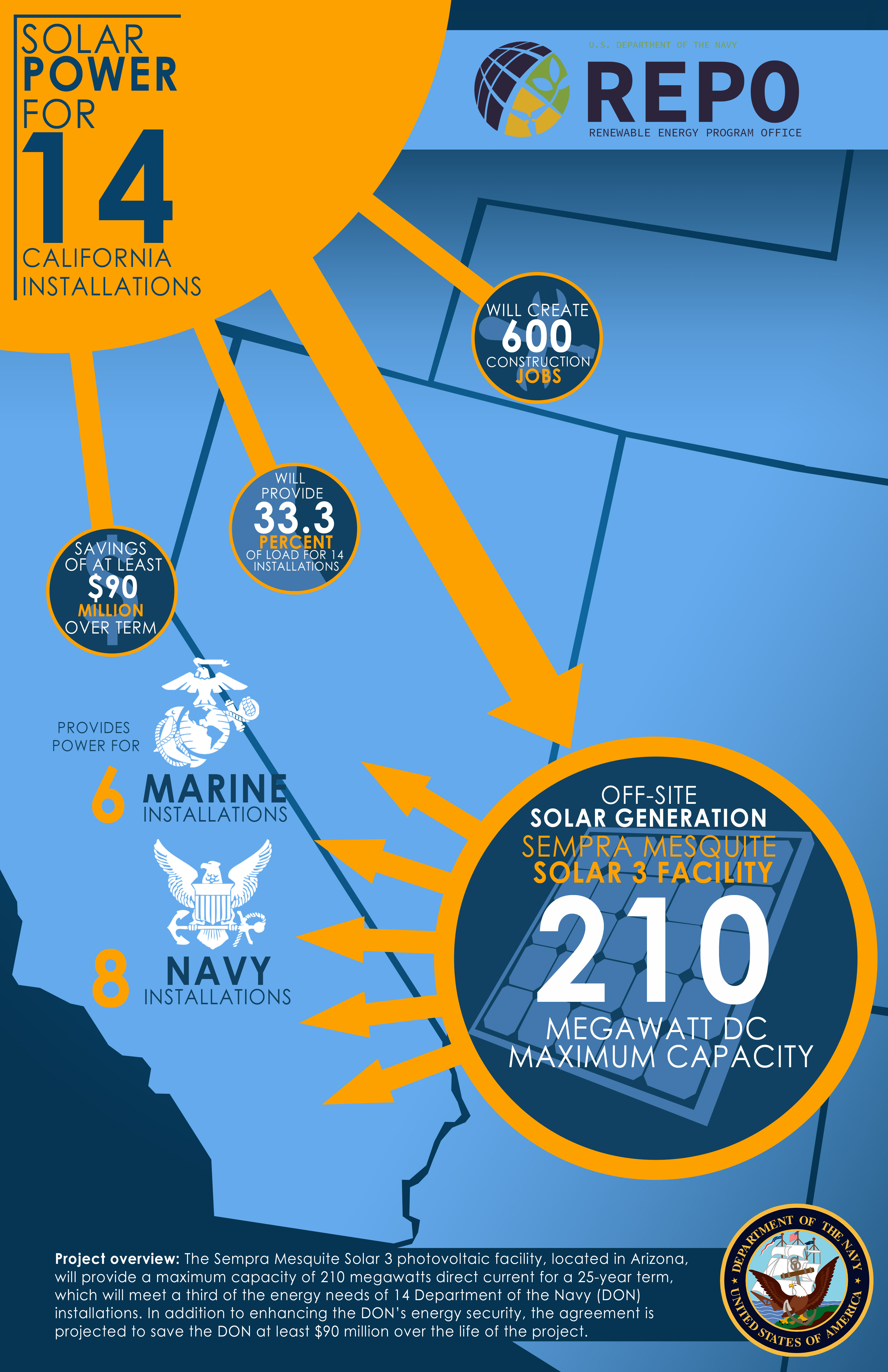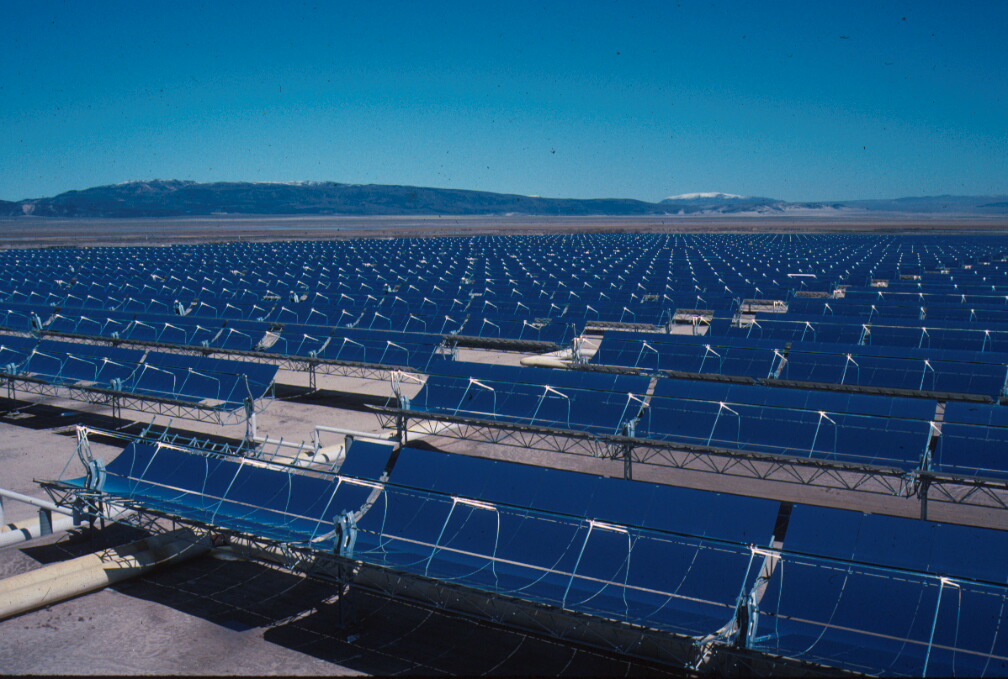Navy and Marine Corps officials gathered in the Arizona desert at midday Friday to dedicate a solar farm that will generate one-third of the electricity to power 14 Navy and Marine Corps installations in California.
The 210-megawatts solar array facility at Sempra U.S. Gas & Power’s Mesquite Solar 3 facility marks the largest purchase of renewable energy by a federal entity, according to the Navy. The Department of the Navy last year signed a 25-year agreement with Sempra, the federal Western Area Power Administration and Shell Energy to purchase solar power, with financial support from the U.S. Department of Energy.
The direct-current facility is expected to generate enough electricity equal to powering about 69,000 homes in California when it is fully operational by the end of 2016, according to Sempra. The Mesquite complex, about an hour west of Phoenix, is one of the nation’s largest photovoltaic farms.
Top officials with the solar pact’s partners gathered for the Friday ceremony that kicked off the start of its commercial operations. “This ceremony marks the completion of one of the first, and most monumental, renewable energy projects undertaken by the Navy,” Dennis McGinn, a retired vice admiral and the Navy’s assistant secretary for energy, installations and environment, said in a Navy press release. “The 14 Navy and Marine Corps installations that will be receiving the power produced by Mesquite Solar 3 will be getting more than just clean, renewable power. They will be getting increased energy resiliency and security, which is crucial to maintaining our mission readiness.”
Those installations are: Naval Bases San Diego, Coronado, Point Loma and Ventura County; Naval Support Activity Monterey; Naval Weapons Station Seal Beach; NWS Seal Beach Detachment Norco; NWS Seal Beach Detachment Fallbrook; Camp Pendleton; Marine Corps Air Ground Combat Center at Twentynine Palms; Marine Corps Air Station Miramar; Marine Corps Logistics Base Barstow; Marine Corps Recruit Depot San Diego; and Marine Corps Mountain Warfare Training Center in Bridgeport.
The Navy, in part led by Navy Secretary Ray Mabus, continues to expand the services’ energy footprint toward more renewable sources including solar, wind, biofuels and even wave energy. Mabus, who in August 2015 signed the 25-year, public-private pact for Mesquite 3, has been vocal in the importance of reducing energy consumption, reducing the reliance on fossil fuels and finding alternative sources, as well as shrinking the services’ carbon footprint.

By 2020, Mabus wants the Navy and Marine Corps to get half its energy needs – afloat and ashore – from non-fossil fuel sources. “It’s pretty ambitious energy goals,” he admitted, in a luncheon talk at the National Press Club on Wednesday in Washington, D.C. Just last year, he said, the services hit the 50 percent mark for its shore-based facilities, five years ahead of the deadline, or more than 1.2 of the 2 gigawatt requirement those facilities need from alternative sources. Interest in renewables is spreading globally, Mabus noted. And at sea, during last summer’s large, multinational Rim-of-the-Pacific exercise, ships from nine countries took biofuel from U.S. Navy ships, he said.
Overall, the Navy has cut its oil use by 15 percent, the secretary said, and the Marine Corps by 60 percent, fueled, in part, by its end of combat operations in Iraq and Afghanistan that had heightened demand. Even Navy SEALs are getting “close to net zero” by using alternative energies, such as purifying water, he added.
Solar energy from Mesquite “will shift our use from brown energy to renewable energy significantly,” 1st Lt. Abigail Peterson, a Marine Corps Installations-West spokeswoman, said in an email. Just how much will the solar power save, compared to fossil fuel costs? That will depend on consumption, more than market fluctuations.
“Since the price is fixed through the agreement, we are unable to estimate the cost projection. In our budgeting process, however, there is value in knowing what the cost of a future requirement will be,” Peterson said.
“For MCIWEST, energy security is a top priority,” she added. “Providing renewable energy to our installations makes them more efficient which means better training for our Marines to project power across the globe.”
In the West, the Mesquite 3 facility’s solar arrays are expected to provide 21 percent of the energy needed to meet Mabus’ one gigawatt goal – already reached – by the end of 2016.
“The Navy has become a leader in renewable energy and advanced biofuels by demonstrating a long term vision to advance clean energy and security,” Energy Secretary Ernest Moniz said in the statement. “The Department of Energy is committed to close cooperation with the Navy on clean energy. Mesquite Solar 1 and 3 exemplify how DOE provides crucial early financing to demonstrate cutting-edge projects at commercial scale for subsequent private sector investment.”
“Our long-standing partnership with the U.S. Navy is a perfect example of our mission dedication,” said Mark Gabriel, WAPA administrator and chief executive officer. “
Together, we strengthen coordination efforts to enhance national energy security and demonstrate federal government leadership as our nation transitions to a low carbon economy. Today, we celebrate the culmination of that partnership, of innovation and technology, and a better way of doing business.” Kevin Sagara, senior vice president and president of Sempra Renewables, praised the partnership with the Navy and WAPA. “These organizations are helping drive our nation’s energy future,” Sagara said in the statement, “and this latest expansion of the Mesquite Solar complex reflects their progressive vision and leadership.”






